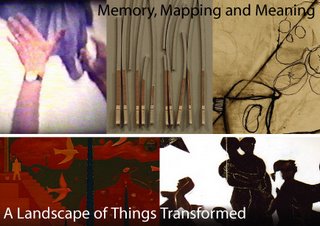Faraway in America

Creative Arts Workshop Hilles Gallery
80 Audubon St., New Haven, (203) 562-4927
A Landscape Of Things Transformed: Fethi Meghelli & K. Levni Sinanoglu
Ends Oct. 15, 2006.
The collaborative show on the first floor level of Creative Arts Workshop's Hilles Gallery is notable for the effective interplay between the primarily monochromatic works of Fethi Meghelli, an instructor in CAW's Drawing and Painting department, and K. Levni Sinanoglu's color oil paintings. In A Landscape of Things Transformed, both mine a shared emotional landscape Sinanoglu described during the opening reception as "faraway-ness."
Meghelli was born in Algeria. When he was a child, Sinanoglu traveled often to Turkey with his Turkish father. In post-9/11 America, it is not difficult to imagine that a familial connection to the Islamic world might foster a sense of otherness. Still, it can't be said that that specific issue plays anything other than a background role in this show.
Meghelli's work is certainly political. His two installation pieces are part of "The War Series," begun two years ago. But conflict is seen in broad terms in these pieces. Rather than get caught up in the crossfire of dueling ideologies or hyperventilating over a "clash of civilizations," Meghelli occupies the terrain in which the lives of innocents are shattered, scattered and splattered. This "collateral damage"—to use the Orwellian euphemism—is portrayed in "The War Series: Hanging" by suspended metal sculptures. Metal pieces cut in the shapes of human figures, animals and detached limbs are bent in contorted poses of agony. Trussed with thin wire, like a tangle of cruel circumstance, they hang from the ceiling, twisting slowly. The metal edges are jagged, for the most part, having a shrapnel-like quality. Amid the work are three non-metal objects: a gravestone-shaped tablet and two baby sneakers. All three are painted black. The sneakers are a poignant reminder of innocence lost in war (a fact our 24/7 cable news vampires deign to shield us from). And the tablet? Perhaps it is a symbol of death. But it might also be a symbol of one of the tablets of the Ten Commandments, here perverted by killers draping themselves in the vestments of warring monotheisms.
"The War Series: The Oil Drum Project" is a mixed media work that wends its way over four walls. It incorporates an oil drum, black sand and a collage of Meghelli's prints and drawings. The oil drum—which Meghelli initially acquired as part of artist Jack Lardis' Oil Drum Project series—is the centerpiece. The cut half of the oil drum is flush against one wall. Out of the top burst black paper flames, a grasping hand and a flailing figure who has lost an arm and a leg. Black sand on the floor surrounds the drum and seeps into the corner, poisoning the earth. The imagery on the walls is propelled by violence over control of the resource. Tumbling figures. Landscapes of explosions and destruction. Echoes of Picasso's Guernica. Mothers trying to shelter their children in their arms. Boats carrying refugees to safety. One such boat has ended up on a separate freestanding wall completely separate from the others, a different continent. While the central placement of the oil drum addresses the cause of the carnage, Meghelli doesn't waste imagery on the perpetrators of these crimes. His witness is reserved for the victims.
Sinanoglu's paintings offer a far different, more pacific, vision. Where Meghelli's world has been torn asunder and soiled with smoke and petro-poison, Sinanoglu's paintings chart a landscape of imagination and fancy. They are characterized by colorful architecture and a dreamy swirl of geometric shapes. There are recurring motifs of birds in flight (echoed deliberately in Meghelli's "Oil Drum" work), masks, tall tapered trees and a robot-like figure. There are three large paintings and two smaller ones; each is characterized by a distinctive color scheme.
In "Exile's Return," red and orange predominate, offset by background greens and the blue-green of the trees in the foreground. The painting next to it, "Black Dog Bardo," scans darker with its deep blues and greens and, dark to almost black birds. Darker still is "Z's Night Flight." A medium-sized painting, this is a surreal night scene. A gray shark lies beached in the foreground. Behind it is a dark blue hive-shaped building. The night sky is roiled by moonlit clouds and dark birds in flight.
Juxtaposed in this venue, the works of these two very different artists evince complementary sensibilities. It is a small show rich in visual beauty and—even where there is righteous anger—warm of heart.

1 Comments:
Hi Hank - Explored your blog. How do you have the time to be so comprehensive and incisive? Is there really a "Hank team" behind the persona? Anyway - I too saw this show - was particularly moved by Levni's pieces. Your summation and insights intersting and useful.
Great service for CT artists and art-lovers.
Keep those art shoes walking!
Hank Paper
11:41 AM
Post a Comment
<< Home